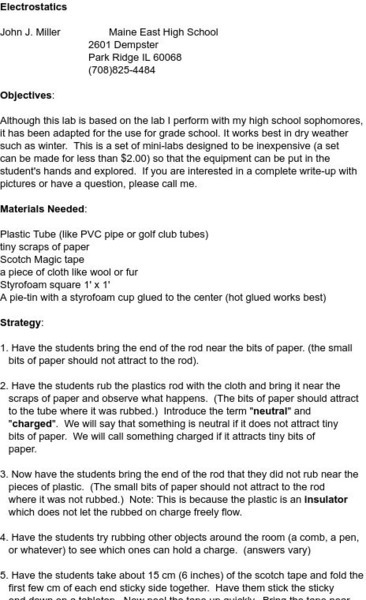Concord Consortium
Concord Consortium: How Does an Object Become Charged?
Activity 2 in this module examines How do objects become charged? An investigation of where the electrons come from and where they go, when atoms become charged.
Concord Consortium
Concord Consortium: How Does an Object Become Charged?
Activity 1 in this module: What is the effect of changing the composition of an atom? Since all atoms contain protons, neutrons, and electrons, what makes one element different from another is examined.
Concord Consortium
Concord Consortium: How Does an Object Become Charged?
This module develops atomic-level causal models to explain observations of electrostatic interactions via the following activities: Activity 1. What is the effect of changing the composition of an atom? Activity 2. How do objects become...
Concord Consortium
Concord Consortium: Where Does All the Energy in an Explosion Come From?
Students construct a model of chemical reactions involving energy and electrostatic interactions and compare reactions and changes in energy through the following activities. Activity 1 What energy changes occur during an explosion?...
Khan Academy
Khan Academy: Electrostatics, Medicine, and Metal Spheres
Read a passage about electrostatics and answer the follow-up questions.
Khan Academy
Khan Academy: Electrostatics Questions
Practice for the MCAT by answering these electrostatics questions.
Wikimedia
Wikipedia: Electrical Conductivity
This is the encyclopedic entry for electrical conductivity from Wikipedia.com. The site provides a brief introduction to the topic but provides numerous links to information relative to the topic.
Concord Consortium
The Concord Consortium: Molecular Workbench: Needle Electroscope
Adjust the electrical change that is present in this needle electroscope simulation.
Concord Consortium
Concord Consortium: Molecular Workbench: Reversing Velocity of Charged Particles
Adjust the particle speed in this simulation and observe how the particle's motion is affected.
Concord Consortium
The Concord Consortium: Molecular Workbench: Electrostatic Interactions
Adjust the amount of positive or negative electrostatic charge on a balloon to see how it interacts with the charges in a wall.
Concord Consortium
The Concord Consortium: Molecular Workbench: Electrostatic Maze Game
Give a particle a positive, negative, or neutral charge to move it through a maze using the positive and negative charges within the maze.
Concord Consortium
The Concord Consortium: Molecular Workbench: Cyclotron
View the motion of a charged particle in a particle accelerator. Watch the arrows used to identify the change in AC current.
Concord Consortium
The Concord Consortium: Molecular Workbench: Charging Your Hair
Adjust the voltage on a Van der Graaff generator to see how the charges will affect a person's hair.
Concord Consortium
The Concord Consortium: Molecular Workbench: Electrical Charge Maze
Position positive and negative charges to help an electron move through a maze to hit a target.
National High Magnetic Field Laboratory
Magnet Academy: Electrostatic Repulsion in Van De Graaff Bubbles
A fun look at how Van de Graaff generators illustrate electrostatic forces. (Java tutorial)
Orpheus Books
Q Files: Electricity and Magnetism: Electric Charge
Learn how electric charges work and about Coulomb's Law, which is used to calculate the strength of an electric force.
Learn AP Physics
Learn Ap Physics: Physics B: Electrostatics
A site dedicated to help students prepare for the AP Physics B test. This specific site reviews electrostatics including electric charges, Coulomb's law, static electricity, electric fields, electric potential, and electrostatic...
Learn AP Physics
Learn Ap Physics: Physics B: Conductors and Capacitors
A site dedicated to help students prepare for the AP Physics B test. This specific site reviews conductors and capacitors including polarization and dielectrics. Site contains links to video lectures and practice problems.
Cosmo Learning
Cosmo Learning: Electric Force
Need to review electric force? This collection of eight video lectures focuses on electric force. Lectures vary in length giving examples of problems to help with the understanding of electric force. Lectures are from a physics course...
Science and Mathematics Initiative for Learning Enhancement (SMILE)
Smile: Electrostatic Models
A teacher lesson plan which includes several hands-on activities pertaining to static charge, charge interactions, and the induction process. Young scholars use readily available materials to investigate these concepts. Designed for...
Science and Mathematics Initiative for Learning Enhancement (SMILE)
Smile: Electrostatics
A teacher lesson plan which includes activities pertaining to common methods of charging objects - induction, conduction, and friction.
Science and Mathematics Initiative for Learning Enhancement (SMILE)
Smile: Electrostatics
From the Science and Mathematics Initiative for Learning Enhancement project at the Illinois Institute of Technology. A teacher lesson plan which includes several Van de Graaff generator demonstrations and some station-style labs....



















